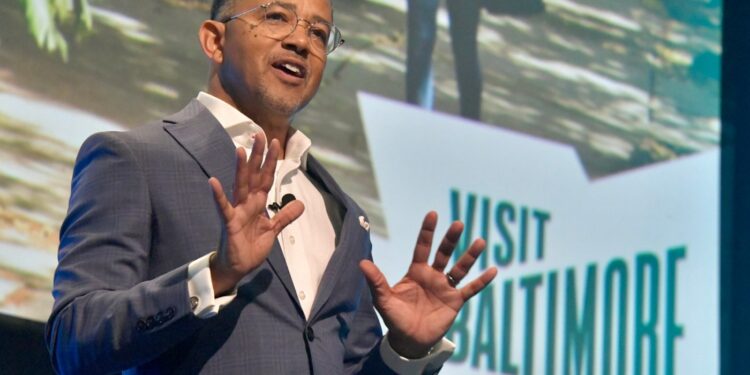
Tourism in Baltimore is on its way back, but investment in the city’s aging convention center will be critical to compete with nearby destinations vying for big meetings and events.
That was the message the city’s convention and tourism bureau delivered to several hundred hospitality professionals, elected officials and others at Visit Baltimore’s annual meeting Thursday afternoon.
“We are still rebounding from the pandemic,” Visit Baltimore President and CEO Al Hutchinson said in an interview Thursday. “2019 was the best numbers we’ve ever had in the industry, but 2020 changed the world.”
Since the coronavirus pandemic, which battered the hospitality sector in Baltimore and across the nation and canceled conventions for months, the number of events and hotel bookings in the city has been increasing slowly.
Last year, the Baltimore Convention Center hosted 55 events. Overall hotel occupancy rates have yet to fully bounce back and hover in the mid-60% range.
By another measure, though, Baltimore has exceeded pre-pandemic levels. Last year, 27.5 million people visited the city, beating the 26.9 million who came in 2019, the last full year before the pandemic. Domestic travel last year generated $4 billion in spending in Baltimore, a 7% jump over the previous year, data from Longwoods International shows.
Officials said momentum is building as investment downtown continues, with $7 billion worth of projects planned or underway. Redevelopment of areas such as the Inner Harbor, Penn Station, and Baltimore Peninsula is expected to contribute to the city’s hospitality sector, Hutchinson said.
“When you add all of that up, it’s going to make Baltimore just a very appealing and attractive destination in the next few years for travelers,” Hutchinson said. “It’s going to make it a very attractive destination for conventioneers, and it’s going to make it an attractive destination for our residents.”
City and state officials have long discussed the need to renovate and possibly expand the convention center to attract more citywide conventions. The facility was last renovated and expanded in 1996.
A state-led convention center task force has been meeting to determine the cost to renovate and modernize the building, and to review governance models, including whether the city should continue to operate the facility. Recommendations are expected to be sent to Gov. Wes Moore by December.
“It’s past time for this building to be invested in,” Hutchinson said. “We’re competing every day with Charlotte, Columbus, Pittsburgh, Cleveland, Milwaukee. All of those communities have new convention centers, and so we’re being held to that standard.”
The task force is assessing how much of an investment is needed, Maryland Commerce Secretary Kevin Anderson said during Thursday’s meeting.
He predicted that the “fast moving project will be transformative to the tourism industry here in Maryland. Tourism is a leader, tourism is important and tourism will help us re-foot this city and this state.”
Visit Baltimore officials booked 174,813 room nights last year for 33 events held at the convention center.
Hotels in Baltimore generated $32 million in taxes in fiscal year 2024, the agency’s annual report showed. Three hotels are currently in development in the city that are expected to add nearly 300 more rooms over the next few years.
Evita Robinson, founder of NoMadness Travel Tribe, a community of more than 30,000 Black and Brown travelers based around the globe, called Baltimore a city of “initiators,” and presented a three-part video series by Visit Baltimore and NoMadness. The series, which will be used to market the city on social media and in ads, explores Baltimore’s role in the civil rights movement and highlights minority-owned businesses.
Earlier this year, the city landed a major future convention for 2033. The American Society of Association Executives (ASAE) Annual Meeting and Exposition is expected to generate economic impact of between $15 million and $18 million and is known as the “Super Bowl” of conventions because of its spin-off impact on future business.
The tourism bureau also is trying to reach out to city neighborhoods. Visit Baltimore unveiled a new mobile visitor center designed to resemble the city’s brick and Formstone rowhouses. “Smalltimore,” introduced at this year’s Preakness Stakes, showcases the city’s history as makers and entrepreneurs and travels to neighborhood’s around the city.
Have a news tip? Contact Lorraine Mirabella at [email protected], (410) 332-6672 and @lmirabella on X.
Originally Published:






